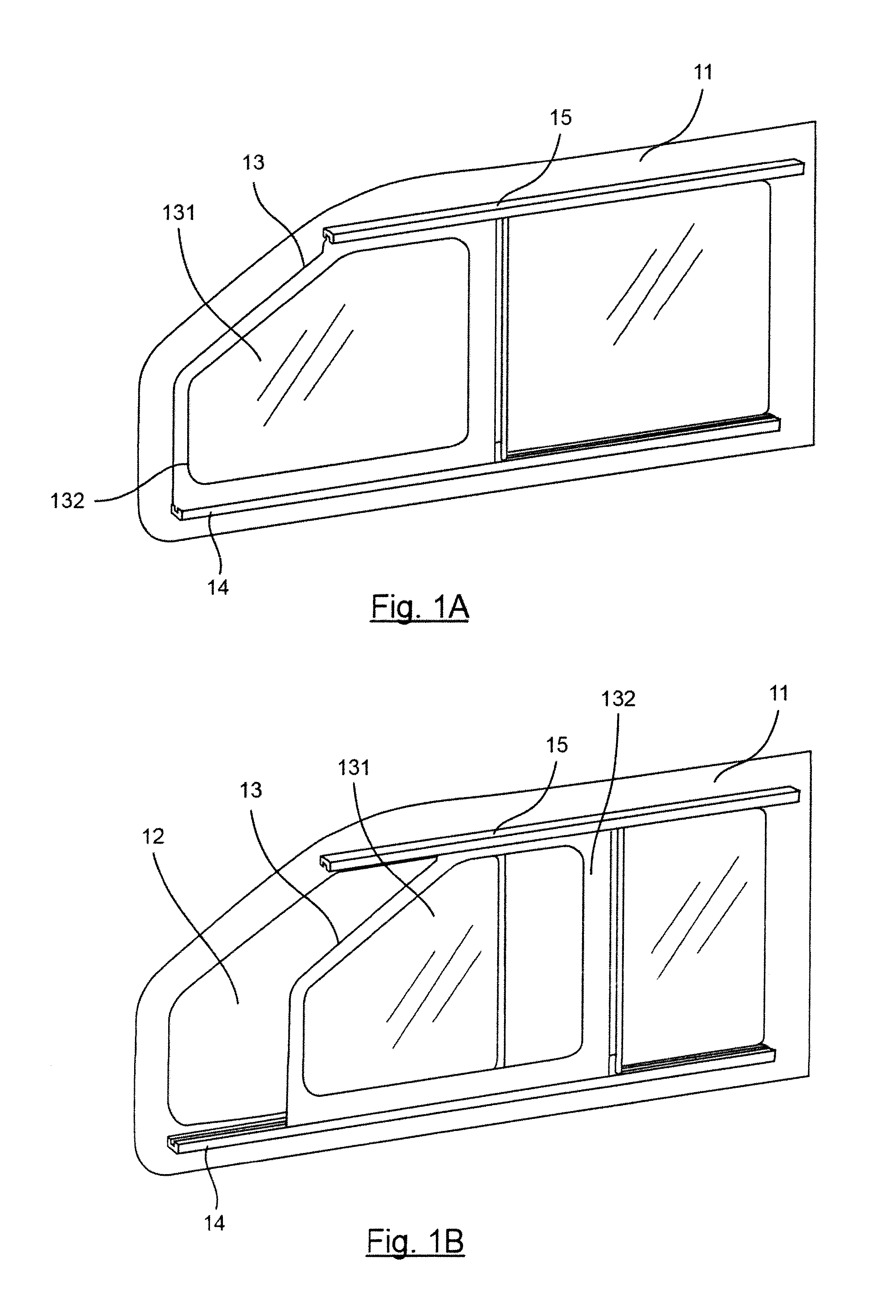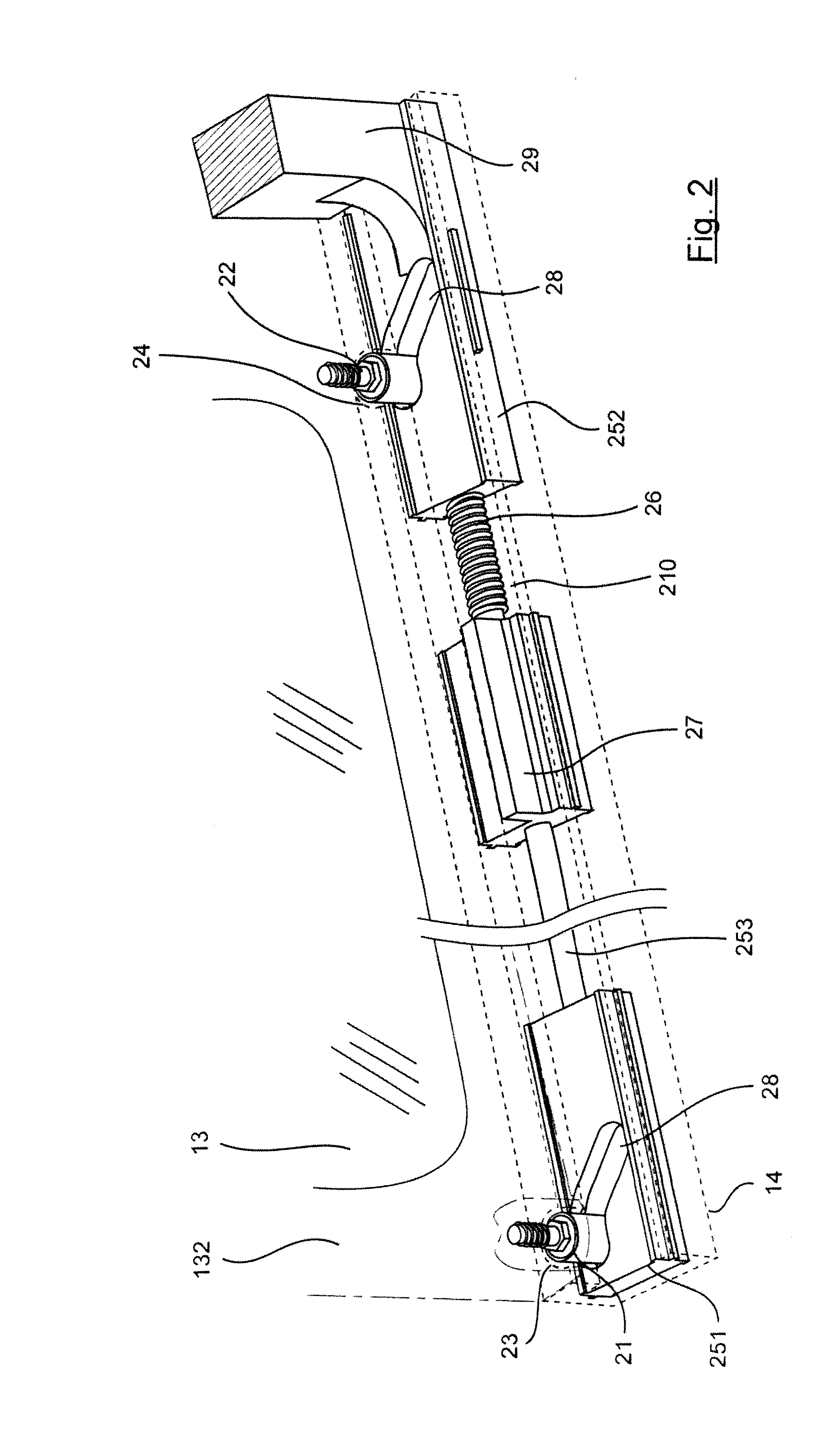Device for closing off an opening made in a structural element comprising synchronization, and corresponding automobile
a technology of synchronization and openings, applied in the field of openings, can solve the problems of many relative drawbacks, interesting techniques are difficult to implement on an industrial scale, and can be used for manual flush openings, arching of mobile panels, or even a complete jamming of these mobile panels
- Summary
- Abstract
- Description
- Claims
- Application Information
AI Technical Summary
Benefits of technology
Problems solved by technology
Method used
Image
Examples
first embodiment
3. First Embodiment
3.1 Balancing and Synchronization
[0106]According to a first embodiment of the invention, the balancing means are mounted in the portion of the frame 46 (or in the handle or pullbar 45) as illustrated by FIG. 5. These balancing means enable the synchronization of at least one upper shuttle and at least one lower shuttle (not shown). Should two shuttles be implemented in each rail, the upper shuttles are, in the same way as with the lower shuttles, rigidly linked by a connection bar as described above with reference to FIG. 2.
[0107]The frame portion 46 therefore comprises a balancing and synchronization system comprising two pulleys 51 and 52 (or more generally cable-guiding means) which cooperate with two balancing and synchronization cables 53, 54 crossing each other at the middle of the frame portion 46 (or in the handle or pullbar 45).
[0108]The first cable 53 has a first portion 531 extending along the rail 421 from a first end 5311 up to the pulley 51. This pul...
second embodiment
4. Second Embodiment
[0124]In this second embodiment, illustrated schematically in FIG. 7, there is provided a handle 71 mounted at the lower part of the mobile panel 43 which acts directly on the lower shuttle (not shown). For example, a substantially horizontal pushing action on the handle 71, in the direction of the arrow 73, provides for the moving of the lower shuttle (or in one variant, the moving of the lower shuttles rigidly linked by a connection bar) relatively to the frame.
[0125]Means for synchronizing 74 transmitting an actuation, transmitted to one of the shuttles, to the other one of the shuttles, also called transmission means here below in the description, are provided between the lower shuttle and the upper shuttle (or between the lower shuttles and the upper shuttles), for example in the form of a synchronization cable circulating in the frame 75 of the mobile panel 72.
[0126]The synchronization cable 74 can especially be a push-pull, to-and-fro cable or a leaf sprin...
third embodiment
6. Third Embodiment
[0142]Referring to FIG. 13, we present a third embodiment in which the handle acts directly on the means of synchronization of the shuttles.
[0143]FIG. 13, which is a partial view of the flush opening, shows that the actuating handle 1301 is mounted on a synchronizing leaf spring 1302 substantially at equal distance from the two shuttles 1303A and 1304A which are rigidly connected by a connecting bar to the shuttles 1303B and 1304B respectively. In one variant of this embodiment, it can also be planned to mount the handle between two leaf springs fixed respectively to either of the shuttles. It can also be planned that the synchronization leaf spring 1302 will not be at equal distance from the two shuttles 1303A and 1304A.
[0144]When this handle 1301 is pulled frontward, in the sense of the arrow 1306, it slides horizontally relatively to the frame 1305 (shown in this figure in dashed lines), synchronously driving the upper portion 1307 and the lower portion 1308 of...
PUM
 Login to View More
Login to View More Abstract
Description
Claims
Application Information
 Login to View More
Login to View More - R&D
- Intellectual Property
- Life Sciences
- Materials
- Tech Scout
- Unparalleled Data Quality
- Higher Quality Content
- 60% Fewer Hallucinations
Browse by: Latest US Patents, China's latest patents, Technical Efficacy Thesaurus, Application Domain, Technology Topic, Popular Technical Reports.
© 2025 PatSnap. All rights reserved.Legal|Privacy policy|Modern Slavery Act Transparency Statement|Sitemap|About US| Contact US: help@patsnap.com



